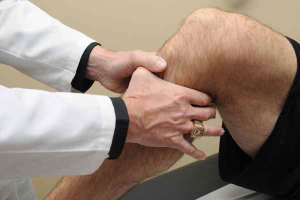The posterior drawer test is the mainstay test for assessment of a PCL tear. However, it has been determined to be relatively inaccurate for objective testing for preoperative and postoperative assessment and should be augmented with the use of PCL stress xrays. In the test, one isolates the function of the PCL at 80°-90° of knee flexion and applies a posterior translation stress to the knee. In the normal knee, there should be no noticeable increase in posterior translation. Thus, if there is some increase in translation one should be concerned that there is a concurrent PCL injury.
The posterior drawer test is performed with the knee flexed to approximately 80°-90°. For this test, it is essential for the knee to be relaxed in order to truly assess the amount of increase in motion that may be present. I usually do this by palpating the hamstring tendons to make sure they are relaxed. If the patient has them tight and they are in bowstring fashion, I gently palpate on them and ask the patient to relax in order to perform the posterior drawer test accurately.
With the foot in neutral rotation and stabilized by sitting on it, or with ones hand, a firm and gentle posterior translation force is applied to the proximal tibia. It is important to make sure that the force is applied straight posteriorly to ensure that one is not performing a posterolateral drawer test. A noticeable increase in posterior translation is then looked for. In general, a relatively inaccurate but commonly used, assessment of a grade I, grade II or grade III tear are recorded. Grade I, or partial tears, usually result in minimal posterior translation of the tibia on the femur and the tibia remains anterior to the femoral condyles with this force. Grade II PCL tears are typically assessed with this method by determining that the tibial plateau falls posterior to be flush with the condyles. However, it is inaccurate in terms of the amount of total posterior translation and stress radiographs must be used to determine the true amount of increased posterior translation. For grade III tears, where the tibia falls posterior to the femoral condyles, there is a high likelihood of a combined ligament injury present and usually the patient will require surgery to alleviate their instability symptoms.

